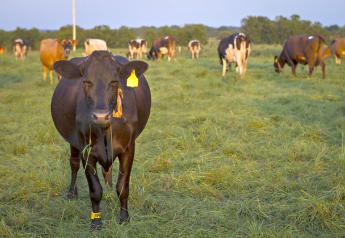Take Care Now for Anaplasmosis

Fly and tick season is here, which means it is time for producers to watch their herds for signs of anaplasmosis. This disease can be devastating to herds if not treated properly or in a timely manner. Anaplasmosis is a parasitic organism that is transmitted through blood by biting insects and ticks, and even surgical instruments like needles. The parasite attaches to red blood cells, which the body then removes, causing animals to become anemic. Cattle, sheep, goats and other wild ruminants can be affected.
Symptoms surface about 21-45 days after infection. Many times, animals can be infected and show no signs of illness. In the acute phase of infection, animals appear weak and generically sick due to anemia. Affected livestock may also exhibit white or yellow mucous membranes, such as their eyes, muzzles or udders. These mucous membranes will appear white due to the lack of red blood cells, or yellow because of the pigments released as red blood cells are broken down and removed from the body. Some animals may even exhibit signs of aggressiveness. This aggressive behavior is caused by lack of oxygen to the brain. Due to being weak, they tend to resort to a ‘fight’ rather than ‘flight’ response.
Anaplasmosis also appears in a chronic form caused by a moderate level of anemia. Affected livestock lose weight over time, which can cause abortions in pregnant cows. In the acute phase, anaplasmosis can be quite fatal if not treated properly. Ill animals need to be treated with great care because the stress of working and handling can be fatal if the disease is advanced.
The most common treatment for the disease is the use of tetracycline antibiotics. Improvement in symptoms can be seen within a few days, but it takes between two to four weeks to see a significant recovery of red blood cell numbers.
Using fly tags, rubs, and pour-on insect repellents to keep biting insects and ticks at bay and thus preventing the disease in the first place is ideal. Changing needles between each animals when vaccinating or administering medicines is also helpful. Another option is to put chlortetracycline in the feed at a low level to kill the organism before it can replicate and attach to red blood cells. Producers can work with their veterinarian and feed supplier to administer chlortetracycline, more commonly known as CTC. There are also many labeled products for injectable oxytetracycline.
Unlike many diseases, which attack young and elderly populations, middle-aged livestock are most affected by anaplasmosis. In fact, most catastrophic cases occur in cattle between six and eight years of age. Younger cattle are better able to regenerate red blood cells and recover, often developing immunity. Cattlemen should pay particular attention to their adult cows and bulls as the season progresses, watching for symptoms characteristic of anaplasmosis.







